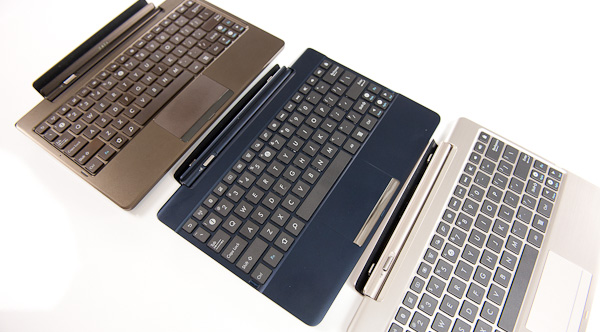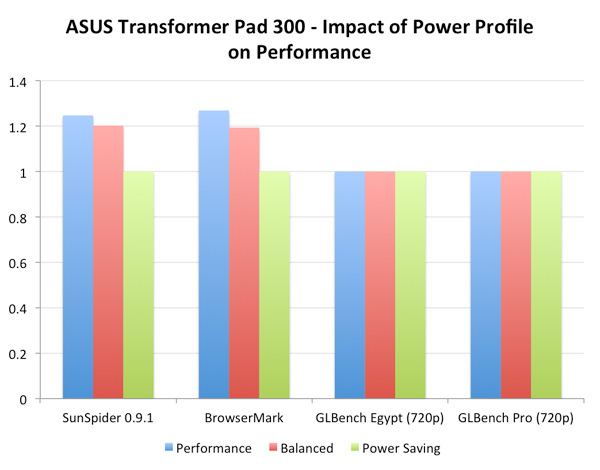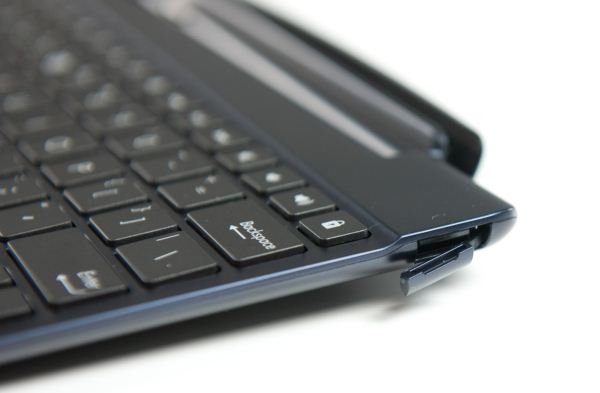ASUS Transformer Pad 300 (TF300T) Review
by Anand Lal Shimpi on April 22, 2012 3:00 AM ESTThe Dock
As this is still a Transformer, you can purchase an optional Transformer dock in a matching color for the 300:
The dock, as always, adds a QWERTY keyboard, trackpad, integrated 16Wh battery, full sized USB 2.0 port and SD card reader. The battery capacity is down from the Prime's dock (22Wh) and as a result extends battery life less than it does in the case of the Prime. I believe we're looking at a classic case of segmentation here, but even so the dock's integrated battery continues to be a brilliant part of the Transformer platform. Not only does it power the keyboard and touchpad but it also charges the 300's battery when docked.
![]()
Google has even added support for external batteries like the Transformer Pad's in Ice Cream Sandwich and you'll actually get two battery status indicators, in addition to an animation showing you how one is charging the other.

From left to right: Transformer dock, TF Pad 300 dock, TF Prime dock
The 300's dock is otherwise nearly identical to the Prime's dock, though it is modified to accommodate the thicker tablet. You can technically use the Prime in the 300's dock but the fit isn't quite secure due to the Prime's thinner form factor. Conversely, the 300 won't fit in the Prime's dock nor the original Transformer's dock - although the actual 40-pin dock connector remains unchanged. The price for the dock is still at $149, identical to what the Prime and original Transformer versions sold for.
The same limitations that came with those older docks apply here as well. With the tablet docked, the contraption is extremely back heavy and can tilt backwards if you're typing on your lap (or any non-flat surface) unless your hands are on the keyboard. The touchpad offers no real protection against accidental taps, although you can disable it via a function key on the keyboard. Although the docked tablet may look like a notebook, the construction isn't quite as solid as an inseparable unibody ultraportable design. The docked TF Pad may look like a Zenbook, but the Zenbook is always going to be more solid (and more expensive) for obvious reasons.
One nitpick I have about the TF Pad 300's dock is the return of the dangling USB port cover. ASUS had something similar on the first Transformer dock, but replaced it with a fully removable rubber stopped for the Prime. On the TF300T, it's back:
All of that said, the dock continues to be the best route for folks who want to do a ton of typing on their tablet - without giving up the portability and convenience of the tablet form factor. On trips you can choose to carry both pieces or just one if you don't plan on doing a lot of typing. At home you can quickly dock and undock the tablet as you shift between usage modes.
Updated Internals
Internally, the Transformer Pad 300 is once again more Prime than original Transformer. Whereas the original Transformer used an NVIDIA Tegra 2 SoC, the Prime and Transformer Pad 300 both use a quad-core (technically 4+1) NVIDIA Tegra 3 SoC. The two differ in their maximum clock speeds.
The Transformer Prime's SoC can run a single core at up to 1.4GHz, and 1.3GHz with more than one core active. The Tegra 3 in the Transformer Pad 300 on the other hand runs at a maximum of 1.3GHz (1 core active) or 1.2GHz otherwise. Note that this difference only exists in the maximum performance mode. Running the balanced power profile, the 300 like the Prime before it runs at a maximum of 1.2GHz regardless of number of active cores. In practice I saw the 300 typically top out at 1.1GHz and only rarely peak at 1.2GHz with the balanced power profile active (see: the three power profiles below).
The Prime's clocked its GPU somewhere around 500MHz, however the TF Pad 300's GPU runs around 400MHz.
| NVIDIA Tegra 3 | ||||
| Max CPU Clock | Max GPU Clock | |||
| NVIDIA Tegra 3 (T33) | 1.6 - 1.7GHz | ? | ||
| NVIDIA Tegra 3 (T30) | 1.4GHz | ~500MHz | ||
| NVIDIA Tegra 3 (T30L) | 1.3GHz | ~400MHz | ||
It's clear that NVIDIA is employing a binning strategy with its Tegra 3 in order to make good use of parts of all yields. The T30 employed in the Transformer Prime ships at nominal clocks, while higher leakage parts (T33) will be used in the upcoming Transformer Pad Infinity that will run at up to 1.6 - 1.7GHz. The lower leakage/lower binning parts (T30L) get used by the Transformer Pad 300, and likely carry a slightly lower cost to ASUS as well.
One advantage the Transformer Pad 300 has internally compared to the TF Prime is its memory. While every single Transformer released thus far has shipped with 1GB of RAM, the 300 is the first to use 1.5V DDR3-667. The TF Prime used 1.5V DDR2-500 as far as I can tell. Don't expect any power savings from the new DRAM, but I believe this is a precursor to the Transformer Pad Infinity with its higher memory bandwidth demands.
I should also add that technically we're reviewing the ASUS Transformer Pad TF300T, the trailing T is for Tegra. ASUS has mentioned that it may introduce 3G and/or LTE equipped versions, the latter would presumably ship with Qualcomm's S4 SoC.
The Three Power Profiles
With the Transformer Prime, ASUS exposed the CPU governor settings for user control via three selectable power profiles. These profiles were originally named Normal, Balanced and Power Saving, however they have since been renamed Performance, Balanced and Power Saving. The behavior of the modes on the Transformer Pad 300 vs. the Prime is below:
| ASUS Transformer Power Profile Settings | ||||
| TF Pad 300 | TF Prime | |||
| Performance |
Max 1C Speed: 1.3GHz Otherwise: 1.2GHz |
Max 1C Speed: 1.4GHz Otherwise: 1.3GHz |
||
| Balanced | Max CPU Speed: 1.2GHz | Max CPU Speed: 1.2GHz | ||
| Power Saving |
Max 1C/2C Speed: 1.0GHz Max 3C Speed: 760MHz Max 4C Speed: 620MHz |
Max 1C/2C Speed: 1.0GHz Max 3C Speed: 760MHz Max 4C Speed: 620MHz |
||
At a high level the main difference between the power profiles is the max CPU speed in performance mode. In Balanced and Power Saving modes these two appear to be equal. The reality is a bit more complex as the Prime tends to deliver lower performance in its Power Saving mode compared to the 300. There's also something funny going on with GPU performance in the Power Savign mode on the 300. With Vsync disabled, there's no performance difference between Power Saving, Balanced and Performance modes on the 300. With Vsync enabled however, we see a ~22% drop in GPU performance with Power Saving enabled.

In general, there's no real performance benefit to using Performance mode but a potentially tangible drop in CPU performance if you switch to power saving. The problem with the latter is that you may not save all that much power as max one or two core clocks aren't much lower than they are under Balanced mode (1.0GHz vs. 1.2GHz). We saw this echoed in our battery life results later on.












37 Comments
View All Comments
Hrel - Monday, April 23, 2012 - link
I wanted to upvote this. But I'm not on reddit:(hackbod - Sunday, April 22, 2012 - link
<quote>Google has even added support for external batteries like the Transformer Pad's in Ice Cream Sandwich</quote>This isn't true, this is a customization that Asus has done. The power of open source, etc., etc.
sprockkets - Sunday, April 22, 2012 - link
That was true of 3.0. You have a source saying it isn't in 4.0?hackbod - Monday, April 23, 2012 - link
You can look at the source code if you want to confirm -- for example look at BatteryService.java and see there is nothing there for reporting multiple batteries.Also I know what stuff we have added to Android in this area, and internal + dock battery is not one of them. :)
XZerg - Sunday, April 22, 2012 - link
Is there a USB port or not on the tablet itself? I noticed the charger is usb based, correct? If so, can that port be used to connect other devices such as keyboards and usb keys?Impulses - Sunday, April 22, 2012 - link
There's no USB port but you can use a 40 pin to USB adapter, it's like $12 (and took forever to come out after the original TF but it's finally readily available as of a few months ago). Other tablets with a micro USB port still require the use of a special USB OTG cable AFAIK, so neither approach is clearly superior.haar - Sunday, April 22, 2012 - link
WELCOME to the niche market!... 80000 transformers sold! lol ...where you have to carry two pieces, a keyboard and screen, so that you can transform it into a notebook that should have been...
so how is a tablet with a 10 inch screen+keyboard any better than the 11 inch macbook air with win8 ...do you think would you use a 11 inch screen in a laptop for everyday work?... when you answer that question for yourself, then you will know if this transformert ablet is good for you.
exact how are you going to remove the perception that you are using a "toy"... dont "real" tech geek use "powerful" processors! HUGE screens!, 1337 Ice cream OS's!!!!
transformer infinity? ... it does NOT exist for sale! why list it in a table?... and because it doesn't exist how can the specs be correct...? making an article 10% ad copy in is beneath Anandtech.com or shoud be!
crankerchick - Sunday, April 22, 2012 - link
Including the Infinity in the spec comparison is very helpful for those of us deciding to wait it out. Obviously it is not a available yet and a performance and quality comparison isn't an option yet, but reminding us of the features helps us keep a mental note that there is something more on the horizon so we can decide if what is different spec wise is worth waiting for. The specs are as correct as can be confirmed by what has been released by ASUS. Get over it.TrackSmart - Sunday, April 22, 2012 - link
Yes, the article was quite informative. I'm researching tablets right now for a relative. The analysis, comparative performance data, and the frank opinion provided in the conclusions were all useful for the decision-making process.And for Haar (above), many of us would be buying this as a tablet only - without the dock. And for use as a entertainment / media consumption device, rather than for work. The only useless information here is your rude comment.
Souka - Sunday, April 22, 2012 - link
stick the iPad3 screen onto the Transformer Infinity guts... "Winner" :)